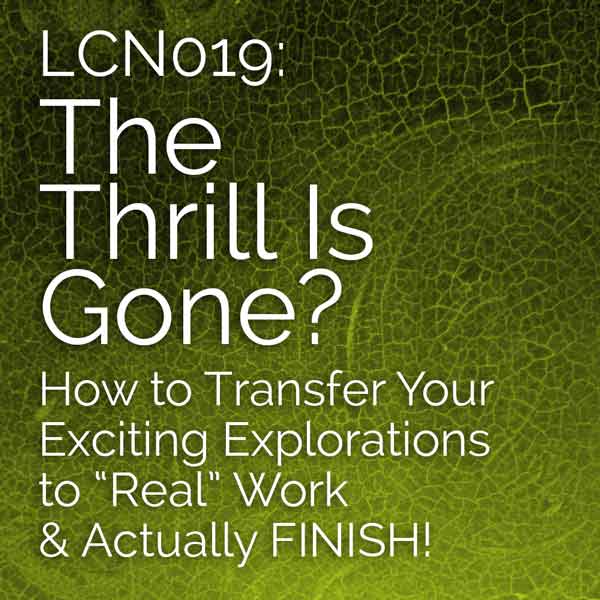
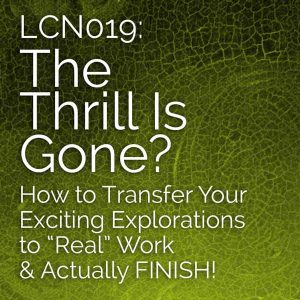 Do your practice projects have way more energy and spontaneity than your “finished” work? Do you choke when you move away from the exploratory phase, so you rarely actually finish something? If so, this episode, in which I answer a listener question, is for you!
Do your practice projects have way more energy and spontaneity than your “finished” work? Do you choke when you move away from the exploratory phase, so you rarely actually finish something? If so, this episode, in which I answer a listener question, is for you!
Sally left the following question in an iTunes review (thank you, Sally!):
Do you have methods/suggestions for dealing with getting the ‘final pieces’ done? I have (finally) created a small space each day to ‘play’ (I took a workshop with Laurie Doctor – if you have had the opportunity, you know how inspiring she is!). I play with techniques I want to explore, I play with color, words, different tools, etc. It is a nice environment where I don’t worry about ‘mistakes’ and I’ve gotten past (most of the time) the fear of making something that isn’t perfect or even very nice in this smaller scale. Further, I have also went and – YIKES – scheduled an exhibition for 2016 (or 17 – still confirming), but now my dilemma. I have THE MOST difficult time transferring what I find exciting and fulfilling in my play to a larger piece. It loses spontaneity, it loses the thrill I had while exploring. I love the small, intimate space of my play-book! Pieces become stale right away. If I do manage to get a little something going on this larger scale, then I reach that point where I kind of like what is happening, but don’t know how to finish it or when to call it finished (this is probably a second question).
– Sally
Thank you for a great question! There’s so much juice to squeeze out here.
First, I want to share a story about playing the guitar on stage.
When I started playing the guitar, I spent hours in my living room, building my chops. When I first took my guitar out of my living room and played in front of more people than my cat, my hands froze! So much adrenaline was coursing through my body that my fingers just didn’t work.
All that work in my living room helped me learn to play in my living room. It didn’t do squat for helping me learn to play on stage, in front of other people, however.
The upshot is: the only way to learn to perform is to practice performing.
For you, as a painter/calligrapher, the only way to learn to do something on a larger scale is to do work on a larger scale.
So that’s the first piece.
The second piece to chew on is this: it may be that once you’ve worked out an idea in your play-book, you’re done with it. You may need to do something new to feel that spark of creative joy.
This is not a problem — this is what I would call a feature.
If the exploring is the exciting part for you, then you may always be swimming upstream every time you move away from the exploration phase into the production phase.
In his book, Uncertainty, Jonathan Fields talks about the creative process having two distinct phases:
- The Insight or Disruption phase
- The Refinement/Expansion/Production phase (REP)
Here’s the thing: most people are energized by one part of the process — it fires them up, makes them feel alive. But the other part of the process sucks them dry.
You might be really good at both parts — and indeed, as solo creators we often have to be good at both parts! But the part that sucks you dry, you’re gonna need some help there.
The part that fires you up, you don’t need help with that — you’re drawn to it, because it feeds you. You love it.
But the other part, it probably gives you the heebie jeebies.
Sally, you sound like me — I’m an insight gal. I love being in the discovery and exploration phase. I want to live there!
This is a big part of why my business creating ketubot on commission for clients ultimately sucked me dry and burned me out: my client work was invariably a job of taking my client’s ideas and generating a visual solution that incorporated all the elements they wanted incorporated.
Creating the sketch was the fun part for me! It was challenging, and yes, sometimes I felt like I was beating my head against a wall, but coming up with the concept, that’s where the juice was. That feeling of satisfaction when I finally arrived at a design concept I was happy with — I would get such a charge from that!
Then I would have to execute it.
That was that part that felt like dragging a very heavy load up a very steep hill.
A lot of my ketubah designs were extremely intricate and meticulous, plus there were always hundreds of words to painstakingly letter out. It could be meditative at times, but because I’m an insight person, I need more than that. It became boring!
And like I said, I’d already gotten 98% of the nourishment this project was going to give me, through the insight phase. Yes, it was always nice to see a finished piece, but over the years it got to the point that the nourishment I got from that barely counteracted the energy drain from the REP phase — refinement, expansion and production.
So, where does that leave us?
Well, since figuring out that I’m an insight person, I understood why I’ve always been drawn to improvisational art forms: social dance forms, like salsa and Argentine tango; jazz and improvisational music; theatrical improv…
When you improvise, you combine the insight and the REP phases into one joint phase — it’s not separated out. Improvising allows me to get a kick of energy throughout as much of the process as possible. So now I intentionally build in improvisation into everything I do.
When I paint, I’ve learned to approach the canvas or paper with little or no preconceived ideas, to just do something, and respond to what’s there. Even when I have a lot going on on the canvas already, I intentionally work to stay in the moment, to not let what’s in my head take me down a particular road when what’s on the canvas is beckoning me down a different road.
This is challenging!
But I think this is why I like it so much. If all I’m doing is executing an idea, then the challenge comes down only to mastering a skill, and it’s easy for me to get perfectionisty and critical of myself, because let’s face it, my skills can always get better.
But when the challenge is one of exploration and free-fall, in a way it’s way scarier, but it gives me that insight phase boost that fires me up. It’s the greatest buzz I think I’ve ever experienced!
Interestingly, now that I’m working in stop-motion animation, I’m finding myself having a greater need to plan ahead, rather than only improvising. I’m looking at how I can incorporate improvisation into what I do, so that it stays fun for me, and doesn’t become only tedious (because face it, snapping 200 pictures of ever-so-slightly different set-ups is just plain tedious!)
So, back to you Sally. The upshot is there are two things you might want to consider playing with:
1) Get out of your play-book. Practice on the paper you want your finished pieces to be on. Start doing your explorations on that paper (or canvas, board, etc.).
and
2) Take what you know about which part of the creative process energizes you, and which sucks you dry, and mindfully approach your next project with that in mind. Switch things up intentionally in order to stay in the part of the process that feeds you most.
One final point:
Your last piece of your question was that when you’re working on a piece at a larger scale
This is why my Creative Sandbox Rule #7 exists: Take the riskier path.
When you’re in the Creative Sandbox, in that space of exploration and play, intentionally do the thing that scares you.
If you’re afraid that you’re going to ruin something — it doesn’t feel finished, and you want to add something but you’re afraid that if you add anything else it will ruin the piece — take that riskier path and risk ruining it!
What’s the worst that’s going to happen? Yes, you may be disappointed if it doesn’t come out the way you wanted, but I guarantee you will learn something from that experience.
And when you get into the practice of doing the thing that scares you it will become less scary! You will become used to that experience of “ruining” something, and figuring out a way to not just salvage it, but maybe find an entirely new direction for your work!
Let me know how it goes!
Resources Mentioned in this Episode
Laurie Doctor, calligrapher, artist, teacher
Uncertainty, by Jonathan Fields
Thanks for Listening!
Thanks so much for joining me this week. Have some feedback you’d like to share? Leave a note in the comment section below!
If you enjoyed this episode, please share it using the social media buttons you see at the bottom of the post.
Also, please leave an honest review for Live Creative Now on Tunes! Ratings and reviews make a big difference in how the show is ranked, and that makes a big difference in helping other people find it, and that helps grow the Creative Uprising!
So you can be an important part of this movement simply by leaving a review.
Plus, if you have a question about living a creative life that you’d like me to address, type it into your review and you may just hear it featured on a future episode! (Yep, to incentivize you to leave a review, I prioritize questions that are left inside reviews. 🙂 )
If you’d also like your voice to be heard on the show, leave your question as a voice message right here.
And finally, don’t forget to subscribe to the show on iTunes to get automatic updates.
Subscribe in iTunes | Subscribe via Stitcher
Now go get creating!

PS — Pssst! Know someone who might benefit from seeing this today? Pass it on!

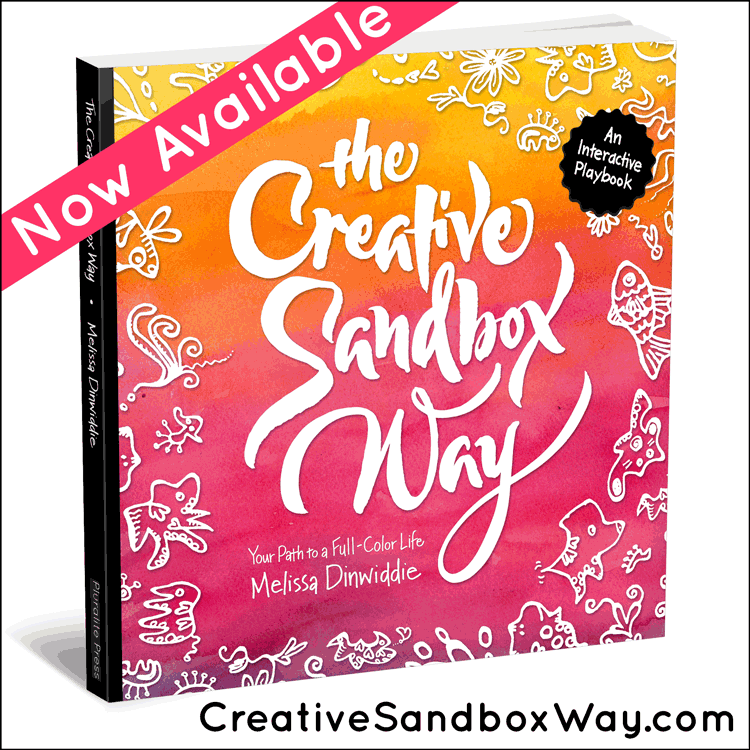
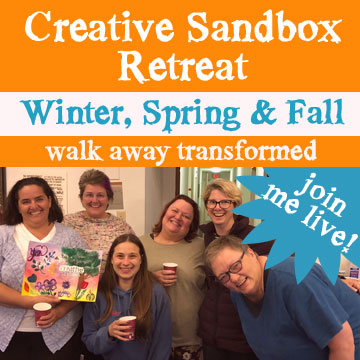
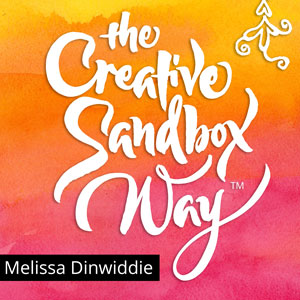

This was great! It’s so important to stay connected with other artists.
Thanks!!
Amen to that, Robert. 🙂
I am thrilled that my question was addressed so quickly and so beautifully! This is SO cool! I’ve been sharing the podcast up to this point – but I’m definitely sharing this one! 🙂
I’m energized and determined to make progress in addressing this stumbling block. There is so much here to chew on and I thank you, Melissa, for doing what you do! Thank you for taking us on YOUR journey and trying to uplift other creative types along the way.
I’m so glad it was helpful, Sally! Thanks for asking such a great question, and thanks for sharing! 🙂